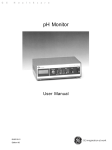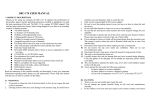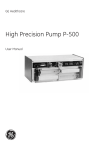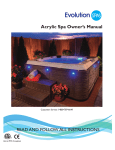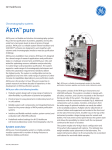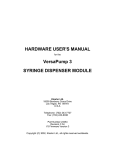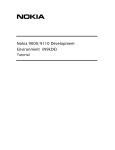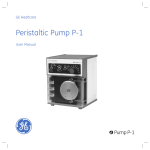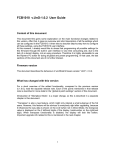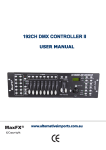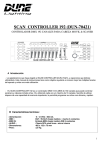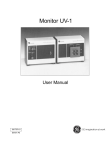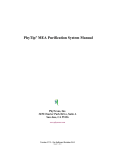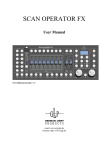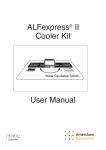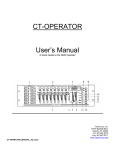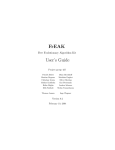Download マニュアル Gradient Programmer GP
Transcript
A M E R S H A M B I O S C I E N C E S Gradient Programmer GP-250 Plus User Manual 56-1153-48 Edition AB Important user information Reading this entire manual is recommended for full understanding of the use of this product. Warranty and Liability Amersham Biosciences guarantees that the product delivered has been thoroughly tested to ensure that it meets its published specifications. The warranty included in the conditions of delivery is valid only if the product has been installed and used according to the instructions supplied by Amershasm Biosciences AB. Amersham Biosciences AB shall in no event be liable for incidental or consequential damages, including without limitation, lost profits, loss of income, loss of business opportunities, loss of use and other related exposures, however caused, arising from the faulty and incorrect use of the product. The exclamation mark within an equilateral triangle is intended to alert the user to the presence of important operating and maintenance instructions in the literature accompanying the instrument. Should you have any comments on this manual, we will be pleased to receive them at: Amersham Biosciences AB S-751 82 Uppsala Sweden Amersham Biosciences AB reserves the right to make changes in the specifications without prior notice. Trade marks SuperFrac ™, FPLC®, and Mono Q® are the exclusive trade marks of Amersham Biosciences AB. In view of the risk of trade mark degeneration, it is respectfully suggested that authors wishing to use these designations refer to their trade mark status at least once in each article. Copyright© 1995 Amersham Biosciences AB All rights reserved. No part of this publication may be reproduced, stored in a retrieval system or transmitted in any form or by any means, without permission in written form from the company. Contents Part 1. Technical description 1. Introduction . . . . . . . . . . . . . . . . . . . . . . . . . . . . . . . . . . . . . . . . . . . . . . . . . . . . . . . . . . . . . . . . . . . . . . . . . . . . . . . . . . . . . . . . . . . . . . . . 3 2. Specifications . . . . . . . . . . . . . . . . . . . . . . . . . . . . . . . . . . . . . . . . . . . . . . . . . . . . . . . . . . . . . . . . . . . . . . . . . . . . . . . . . . . . . . . . . . . . . . 4 3. Unpacking . . . . . . . . . . . . . . . . . . . . . . . . . . . . . . . . . . . . . . . . . . . . . . . . . . . . . . . . . . . . . . . . . . . . . . . . . . . . . . . . . . . . . . . . . . . . . . . . . . 6 4. Description of keyboard and programming . . . . . . . . . . . . . . . . . . . . . . . . . . . . . . . . . . . . . . . . . . . . . . . 7 4.1 Control keys . . . . . . . . . . . . . . . . . . . . . . . . . . . . . . . . . . . . . . . . . . . . . . . . . . . . . . . . . . . . . . . . . . . . . . . . . . . . . . . . . . . 8 4.2 Calibration block . . . . . . . . . . . . . . . . . . . . . . . . . . . . . . . . . . . . . . . . . . . . . . . . . . . . . . . . . . . . . . . . . . . . . . . . . . . . 9 4.3 Evaluation block . . . . . . . . . . . . . . . . . . . . . . . . . . . . . . . . . . . . . . . . . . . . . . . . . . . . . . . . . . . . . . . . . 10 4.4 Manual block . . . . . . . . . . . . . . . . . . . . . . . . . . . . . . . . . . . . . . . . . . . . . . . . . . . . . . . . . . . . . . . . . . . . . . . . . . . . . . . . 11 4.5 Method block . . . . . . . . . . . . . . . . . . . . . . . . . . . . . . . . . . . . . . . . . . . . . . . . . . . . . . . . . . . . . . . . . . . . . . . . . . . . . . . . .12 4.6 Programming block . . . . . . . . . . . . . . . . . . . . . . . . . . . . . . . . . . . . . . . . . . . . . . . . . . . . . . . . . . . . . . . . . . . . . . . .12 4.7 List of instructions . . . . . . . . . . . . . . . . . . . . . . . . . . . . . . . . . . . . . . . . . . . . . . . . . . . . . . . . . . . . . . .13 4.8 Review block . . . . . . . . . . . . . . . . . . . . . . . . . . . . . . . . . . . . . . . . . . . . . . . . . . . . . . . . . . . . . . . . . . . . . . . . . . . . . . . . . . 15 4.9 Display . . . . . . . . . . . . . . . . . . . . . . . . . . . . . . . . . . . . . . . . . . . . . . . . . . . . . . . . . . . . . . . . . . . . . . . . . . . . . . . . . . . . . . . . . . 16 4.10 LED indicators . . . . . . . . . . . . . . . . . . . . . . . . . . . . . . . . . . . . . . . . . . . . . . . . . . . . . . . . . . . . . . . . . . . . . . 17 4.11 Short instruction . . . . . . . . . . . . . . . . . . . . . . . . . . . . . . . . . . . . . . . . . . . . . . . . . . . . . . . . . . . . . . . . . . . . . . . . . . . . .17 5. Description of rear panel and connections . . . . . . . . . . . . . . . . . . . . . . . . . . . . . . . . . . . . . . .18 5.1 Mains power supply . . . . . . . . . . . . . . . . . . . . . . . . . . . . . . . . . . . . . . . . . . . . . . . . . . . . . . . . . . 18 5.2 Pumps . . . . . . . . . . . . . . . . . . . . . . . . . . . . . . . . . . . . . . . . . . . . . . . . . . . . . . . . . . . . . . . . . . . . . . . . . . . . . . . . . . . . . . . . . 18 5.3 Fraction collectors . . . . . . . . . . . . . . . . . . . . . . . . . . . . . . . . . . . . . . . . . . . . . . . . . . . . . . . . . . . . . . . . . . . . . . . 20 5.4 Recorders . . . . . . . . . . . . . . . . . . . . . . . . . . . . . . . . . . . . . . . . . . . . . . . . . . . . . . . . . . . . . . . . . . . . . . . . . . . . . . . . . . . . 21 5.5 Method control (inports) . . . . . . . . . . . . . . . . . . . . . . . . . . . . . . . . . . . . . . . . . . . . . . . . . . . . . . . . . . . . . 22 5.6 Programmable outports . . . . . . . . . . . . . . . . . . . . . . . . . . . . . . . . . . . . . . . . . . . . . . . . . . . . . . . . . . . . . . . 23 5.7 Logic ground . . . . . . . . . . . . . . . . . . . . . . . . . . . . . . . . . . . . . . . . . . . . . . . . . . . . . . . . . . . . . . . . . . . . . . . . . . . . . . 24 5.8 Mixer. . . . . . . . . . . . . . . . . . . . . . . . . . . . . . . . . . . . . . . . . . . . . . . . . . . . . . . . . . . . . . . . . . . . . . . . . . . . . . . . . . . . . . . . . . . . 24 6. Installation and connection of equipment . . . . . . . . . . . . . . . . . . . . . . . . . . . . . . . . . . . . . . . . . . . . . . . . . . . 25 6.1 Mains installation . . . . . . . . . . . . . . . . . . . . . . . . . . . . . . . . . . . . . . . . . . . . . . . . . . . . . . . . . . . . . . . . . . . . . . . 25 6.2 Connection of pumps.. . . . . . . . . . . . . . . . . . . . . . . . . . . . . . . . . . . . . . . . . . . . . . . . . . . . . . . . . . . . . . . . . . 26 6.3 Connection of recorder. . . . . . . . . . . . . . . . . . . . . . . . . . . . . . . . . . . . . . . . . . . . . . . . . . . . . . . . . . . . . . . . 27 6.4 Connection of fraction collector . . . . . . . . . . . . . . . . . . . . . . . . . . . . . . . . . . . . . . . . . . . . . . . . . . . 28 6.5 Connection of mixer . . . . . . . . . . . . . . . . . . . . . . . . . . . . . . . . . . . . . . . . . . . . . . . . . . . . . . . . . . . . . . . . . 28 6.6 Connection of accessories to the programmable outports . . . . . . . . . . . . . 28 7. Operation . . . . . . . . . . . . . . . . . . . . . . . . . . . . . . . . . . . . . . . . . . . . . . . . . . . . . . . . . . . . . . . . . . . . . . . . . . . . . . . . . . . . . . . . . . . . . . . . 32 7.1 Start-up . . . . . . . . . . . . . . . . . . . . . . . . . . . . . . . . . . . . . . . . . . . . . . . . . . . . . . . . . . . . . . . . . . . . . . . . . . . 32 7.2 Programming a method . . . . . . . . . . . . . . . . . . . . . . . . . . . . . . . . . . . . . . . . . . . . . . . . . . . .32 8. Check codes . . . . . . . . . . . . . . . . . . . . . . . . . . . . . . . . . . . . . . . . . . . . . . . . . . . . . . . . . . . . . . . . . . . . . . . . . . . . . . . . . . . . . 35 9. Maintenance and servicing . . . . . . . . . . . . . . . . . . . . . . . . . . . . . . . . . . . . . . . . . . . . . . . . . . . . . . . . . . . . . . . . . . . . . . . 38 10. Troubleshooting . . . . . . . . . . . . . . . . . . . . . . . . . . . . . . . . . . . . . . . . . . . . . . . . . . . . . . . . . . . . . . . . . . . . . . . . . . . . . . . . . . . . . . . 39 11. Technical appendix . . . . . . . . . . . . . . . . . . . . . . . . . . . . . . . . . . . . . . . . . . . . . . . . . . . . . . . . . . . . . . . . . . . . . . . 40 12. Spare parts and accessories . . . . . . . . . . . . . . . . . . . . . . . . . . . . . . . . . . . . . . . . . . . . . . . . . . . . . . . . . . . . . 42 Part 1. 2. 3. 4. 2. Applications Elution schemes . . . . . . . . . . . . . . . . . . . . . . . . . . . . . . . . . . . . . . . . . . . . . . . . . . . . . . . . . . . . . . . . . . . . . . . . . . . . . . . . . . . . . . . . 44 Sample injection. . . . . . . . . . . . . . . . . . . . . . . . . . . . . . . . . . . . . . . . . . . . . . . . . . . . . . . . . . . . . . . . . . . . . . . . . . . . . . . . . . . . . . . . 49 Fraction collection. . . . . . . . . . . . . . . . . . . . . . . . . . . . . . . . . . . . . . . . . . . . . . . . . . . . . . . . . . . . . . . . . . . . . . . . . . . . . . . . . . . . . 50 Looping a method for manual repeated injection . . . . . . . . . . . . . . . . . . . . . . . . . . . . . . . . . . . . . . . . 51 1. Introduction Part 1 1. Introduction The Gradient Programmer GP-250 Plus (Code No. 20-0002-02) is a powerful, multi-functional control unit for chromatography systems. Its programmable memory allows you to control chromatographic procedures, modify separation parameters and control auxiliary equipment such as fraction collectors and chart recorders at the same time. Fifty independent methods can be programmed and stored in the battery backed-up memory of the GP-250 Plus. Each method maybe accessed individually, linked to other methods or called upon as a submethod. In addition, methods or parts of methods may be looped up to 99 times. Programmed settings may be overridden manually at any stage. Together with prepacked columns, pumps, valves, monitors, fraction collectors and recorders, the GP-250 Plus forms a systems for fast, highresolution liquid chromatography, such as FPLC® System. This instruction manual is divided into two parts. In the first part “Technical description” you will find all the technical details about the GP-250 Plus. There is also a trouble-shooting section and a check code list. The second part “Applications” provides a set of useful examples which will get you started easily. In the FPLC System handbook you will find chapter 3, “Programming”, which is an easy start-up course in how to program the GP-250 plus. 3 2. Specification 2. Specification This section provides general specifications. For full details of functions, instructions and interface signals, see section 4 “Description of keyboard and programming” and section 5 “Description of rear panel and connections”. Method number 50 methods can be programmed individually. The methods are divided into 5 different method banks with 10 methods in each bank. Memory capacity Maximum memory capacity is 750 instructions. Memory protection The memory is backed-up with a lithium battery that will last for a minimum of 5 years. A LED indicates when the battery should be replaced. Warning! ● Due to the risk of explosion, always contact a Amersham Biosciences service technician to replace the battery. Display 16 digit alphanumeric display with 5 LEDs for status information. Keyboard 29 click-type keys with audible tone acknowledgement. The tone will become louder when incorrect key entries are made. Alarm An audible alarm can be programmed to sound at any time (volume) with a duration of 0-99 min in increments of 0.1 min. There will also be a 30 s alarm when a check code is indicated in the display. Method base Programmed instructions are executed in either time or volume base depending on whether the GP-250 Plus is calibrated in min, ml or dl; 0-9 999 min(ml,dl). Increment: 0.01 in the region 0-99.99 0.1 in the region 0-999.9 1 in the region 1 000-9 999 Sub-method call Programmed methods can be called upon as sub-methods. Maximum is 9 levels of nesting. Looping A part or a whole method can be looped 1-99 times. Gradient formation The gradient is formed by the control of either two pumps or one pump and a switch valve. Eluents are then mixed in a dynamically stirred mixing chamber. The supplied mixer has a volume of 0.6 ml, with magnetic stirring. Concentration 0-100 % B in 0.1% increments. Gradient profiles Any gradient profile can be programmed in linear segments of different slopes. Linear gradients are programmed by entering the time (volume) and concentration of eluent B at the breakpoints. The concentration entered will be reached at the programmed time (volume). The concentration will be changed linearly between the breakpoints. Programmable outports Seven programmable ON/OFF outports, e.g. for control of accessory equipment, TTL compatible. Three are designed for control of a fraction collector or automatic injector. The polarity for each outport can be programmed in the Calibration block. 4 2. Specifications 24 V Switched power outports Three 24 V (max. 100 MA) switched power outports are available, of which two are designed to power solenoid valves etc. and one for making onepump gradients. The third is also useable as an outport for solenoid valves when using two pumps for gradient formation. The power outports are powered down 30 ms after any of the outports are activated to avoid overheating the valves. Power 24 V A 24 V power source for external devices. Memory protection Four inports for remote method control and indications, e.g. Level sensors, TTL compatible. Environment +4 to +40 °C, 20–95 % relative humidity, 84–106 kPa (840–1060 mbar) atmospheric pressure Dimensions 408x308x122 mm Weight 5.5 kg Power requirement 50 VA Voltage 100/120/220−230/240 V Always connect the instrument to a properly grounded mains outlet. Frequency 50-60 ± 2 Hz EMC standards This product meets the requirement of the EMC Directive 89/336/EEC through the harmonized standards EN 50081-2 (emission) and EN 50082-1 (immunity) Note: This is a class A product. In a domestic environment this product may cause radio interference in which cases the user may be required to take adequate actions. Note: The declaration of conformity is valid for the instrument when it is : ● ● ● used in laboratory locations used in the same state as it was delivered from Amersham Biosciences AB except for alteration described in the User Manual used as “stand alone” unit or connected to other CE labelled Amersham Biosciences products or other products as recommended Safety standard This product meets the requirement of the Low Voltage Directive (LVD) 73/23/EEC through the harmonized standard EN 61010-1. Power failure/ disturbances In the event of power failure the system will shut down. When the disturbances power returns the run will continue exactly where interrupted. Pump control The GP-250 Plus can control pump functions such as RUN/PAUSE, flow rate and wash program. If the pump is inoperable or is busy, a check code is given in the display. All signals are TTL compatible. Flow rate 0-999 ml/min in min mode 0.02 -75.0 ml/min in ml mode 0.02 -75.0 dl/min in dl mode Increment: 0.01 in the region 0.00-9.99 0.1 in the region 10.0-99.9 1 in the region 100-999 The Pumps P-1, HiLoad™ Pump P-50, High Precision Pump P-500, and P-6000 can be controlled within their whole flow rate range. 5 2. Specifications, 3. Unpacking Recorder control Chart speed 0-999 cm/min(ml,dl) Increment: Pen down Gradient 1 V 0.01 in the region 0.00-9.99 0.1 in the region 10.0-99.9 1 in the region 100-999 Output to control a solenoid pen down function on a recorder. Automatic pen down when chart speed is set to a non-zero value. Analog signal, 0-1 V, reflecting the current concentration in % of eluent B during a run. 1 V corresponds to 100% B. Resolution 0.001 V (0.1% B). Fraction collector control The GP-250 Plus can control a fraction collector to RUN/STOP, PAUSE/CONTINUE, FEED TUBE and RECYCLE (recycle is possible only with FRAC-200 and SuperFrac™). 3. Unpacking Unpack the equipment carefully and check the contents of the carton against the packing list. Save the packing material and the carton if future transport can be foreseen. Check the GP-250 Plus for any visible signs of damage that may have occurred during transit. Place the GP-250 Plus on the bench and check that it has the appropriate voltage setting (see section 5.1 “Mains , power supply”). Before operating the unit, read section 6, “Installation and connection of equipment” carefully. 6 4. Description of keyboard and programming 4. Description of keyboard and programming The keyboard (Fig. 1) is of touch-type and has very good chemical resistance. It contains function keys and numerical keys. The function keys can be divided into three groups; control keys for manual control e.g. of a method in progress, special function keys for entering different blocks which contain instructions to be executed or programmed and special keys for the Review block. The different blocks available are shown in Fig. 2. Fig. 1. The keyboard Fig. 2. Block scheme Keys for data entry [0], [1], . . . [9] Data entry [.] Decimal point [CE] Clear entry Resets entered data to 0. 7 4. Description of keyboard and programming 4.1 Control keys Feeds paper on the recorder. Resets a programmed alarm or check code. Stops a running method, resets all activities and sets functions to initial (inactive) conditions. RUN METHOD O is displayed. Concentration is set to 0. Flow rates are set to 0. Chart speed is set to 0. Outports are set to the inactive states. Tube number is set to 1. Note: [end] will have a special function during pump calibration. Only valid during run. When pressed, current values are maintained until [cont] is pressed or until the trailing edge of a remote hold signal on method control “hold” (rear panel no. 25). The method is not advanced, but retention time (volume) will be counted. Values can be changed manually during hold, as during run and pause. A LED is switched on to indicate hold gradient. Continues the run after hold gradient, pause, a programmed hold, remote pause on method control “pause” (rear panel no. 26) or remote hold on method control “hold” (rear panel no. 25). The pumps, the fraction collector and the recorder are stopped until [cont] is pressed or until the trailing edge of a remote pause signal on method control “pause” (rear panel no. 26). The method is not advanced and time (volume) will not be counted until [cont] is pressed. Parameters can be changed manually during pause, but flow rate and chart speed will not be executed until [cont] is pressed or until the trailing edge of a remote pause signal on method control “pause” (rear panel no. 26). A LED is switched on to indicate pause. Exits Method, Calibration, Evaluation, Review and Manual blocks and returns to initial mode i.e. RUN METHOD or run parameters. In the Programming block, [exit] must be pressed once more to return to initial mode. Selects functions or instructions in different blocks. Step forward to get the next function/instruction and backward to get the previous function/instruction. Executes methods/instructions or stores data entered in memory. 8 4. Description of keyboard and programming 4.2 Calibration block Not accessible during run. By pressing this key, the Calibration block is entered. This block contains data needed by the GP-250 Plus to control the pumps and recorder. It also contains data defining outports etc. This block is left by pressing [exit]. When pressing [step forward] or [step backward], the following calibration choices are given: MIN.0 ML.1 DL.2 Selects the base for advancing the method. Enter 0 (= MIN), 1 (= ML) or 2 (= DL) (1 deciliter, DL, = 100 ML.) A LED is switched on to indicate if ML or DL was chosen. PUMP CAL AB Enters the calibration value for pumps A and B, i.e. the number of pulses the GP-250 Plus has to send to the pumps to deliver 0.1 ml(dl). Calibration values in ml mode are 234 for P-50, 110 for P-500, and 45 for P-6000. In dl base the calibration value for the P-6000 is 4 500. Note: Pump P-50 and P-500 cannot be run in dl mode. REC CAL Enters the calibration value for the recorder, i.e. the number of pulses the GP-250 Plus has to send to the recorder to feed 1 cm of paper (200 for REC 101/102). CALIBRATE PUMP A Allows calibration of a pump connected to the connector PUMP A. For calibrating a peristaltic pump, connect it to the PUMP A socket and follow the procedure below. Do not forget to change the connections and re-enter PUMP A calibration value after you have finished the procedure. The procedure is according to the following scheme: 1. Fill the pump with suitable liquid, e.g. water, (before connecting it to GP-250 plus). 2. Connect the pump to the PUMP A connection on rear panel. Turn on the pump. 3. Set a representative flow rate on the control panel of the pump, (approx. 1 ml/min. ). Place the outlet from the pump into a graduated cylinder. 4. Press [do store]. The run LED is switched on and pump A control from the GP-250 Plus is released so pump A can start with the flow rate set on the pump. The GP-250 Plus is now counting pulses from the stepper motor in the pump. 5. Press [end] when a volume large enough to be measured with good accuracy has been delivered, e.g. 10 ml. 6. VOLUME.ML is displayed (or VOLUME. DL if dl mode is chosen). Enter the collected volume and press [do store]. 7. The calibration mode is terminated and the display will show PUMP CAL AB as above but with a new calibration value. CLEAR MEMORY Clears all memory of the GP-250 Plus. Enter 441 and press [do store]. The display will then show RUN METHOD. MIX VOLUME For two pump systems the mixvolume should be set to zero (0). If set to a non-zero value (10-9 999 ml or 1-999 ml) the GP-250 Plus assumes that gradients will be formed with a single pump A and a switch valve. The valve must be connected to the switch valve socket no. 5-7 on the rear panel of the GP-250 Plus. 9 4. Description of keyboard and programming Recommended mix volume for the 0.6 ml mixer is 60 and for 6 ml mixer is 600. If another pump is used, please contact your Amersham Biosciences representative for further information. Note: When running in dl mode the mix volume is 1-999 ml. As the display shows 10-9 999, the entered value has to be divided by 10 to get the correct value i.e. 15 on the display means 1.5 ml mix volume. P. POL Sets polarity for the programmable outports. Positive or negative logic can be selected for outports 0-4 and 8-9. Ports 5-7 connected to the fraction collector cannot be changed. 3.1 means port 3 has positive logic (active = floating voltage). 3.0 means port 3 has negative logic (active= 0 V). Negative logic is normally used. Default means that all ports have negative logic except 1 and 2. Port 0 is designed for a switch valve when making gradients with one pump. When not used for a switch valve it can be used for an extra solenoid valve. If you want to connect an extra pump (P-1) and both outports 1 and 2 are occupied, connect the pump to outport 8 and change its polarity by entering 8.1 and pressing [do store]. 4.3 Evaluation block By pressing this key, the Evaluation block is entered. The data below will be shown by pressing [step forward] or [step backward]. The data reflects the current value, i.e. the displayed values will be continuously updated. This block is left by pressing [exit]. RETENTION Shows accumulated time (volume). LOOP NO Shows the loop counter value for the running method. When both a calling method and a method to be called contain instructions for looping, the counter value will refer to the method currently running. When not in a loop, no value will be shown at all. PATH Shows the current “call path” e.g. method 1 in bank 1 is started. It calls method 2 in bank 3. The display will show: 1.1 c2.3 Call method (CALL MET) is shown as c Up to four levels of calls can be shown. If the nesting is deeper than four levels, the four lowest levels will be shown. A “c” directly to the right of PATH will indicate that all levels are not displayed. TUBE NO Shows which tube number the fraction collector is presently collecting into. If no fraction collector is connected or the fraction collector is not started, 1 will be shown. 4.4 Manual block By pressing this key the Manual block is entered. It allows initial conditions to be set before starting a method or parameters to be changed in a running method without changing the program. If either or both the pumps and the recorder are started, the run LED is switched on. 10 4. Description of keyboard and programming The displayed value reflects the current value and is continuously updated. This block is left by [exit]. The list below shows the instructions that can be changed. They are reached by using [step forward] and [step backward]. For more information see section 4.7 “List of instructions”. CONC %B Changes the concentration of buffer B. ML(DL)/MIN Changes the flow rates of pumps A and B. CM/MIN Changes the recorder chart speed: shown as CM/MIN if time is used as base and CM/ML(DL) if volume is the base. PT Shows the status of attached outports i.e. active or inactive e.g. . PT 0.0.1.0.0.0.0.0.0.0 indicates that port 2 is active. To set port 5 active enter 5.1. Port 0 is switch valve or user-definable outport Ports 1-4 are user-definable outports Port 5 is fraction collector pause (1), continue (0) Port 6 is fraction collector run (1), end (0) Port 7 is fraction collector recycle (1), reset (0) Ports 8-9 are user-definable outports. Note: Default values for active electrical signals are different for ports 1 and 2 than the others. See section 5.6 “Programmable outports”. WASH A.B. Activates the wash program in pumps A and B if they have the function (e.g. P-500 and P-6000). To activate the wash program in pump A enter 1.0; to activate the wash program in pump B enter 0.1; to activate the wash program in both pumps, A and B, enter 1.1. When the wash program is activated, the pump(s) will set the GP-250 Plus in pause until the program is completed. The wash program can be terminated with [end]. Note: When running the wash program, the injection valve must be in the wash position in order to protect the column from the exposure of high flow rates. During wash there will be no check code if the overpressure alarm is activated. FEED TUBE Changes tube on the fraction collector when [do store] is pressed. SYNC A.B Drives the pump pistons to an end position if the pumps are provided with the function (e.g. P-500 and P-6000). Useful for gradients of very small volumes. Enter 1.0 for driving the pump A piston to an end position, 0.1 for pump B and 1.1 for both pumps. When the sync program is activated, the pumps will set the GP-250 Plus in pause until the program is completed. The sync program can be aborted with [end]. Note: When running the sync program the injection valve must be in the wash position, in order to protect the column from the high flow rates. Only for use with pumps that are provided with the function e.g. P-500 and P-6000. Otherwise the high flow rate could seriously damage the pump. 11 4. Description of keyboard and programming 4.5 Method block The GP-250 Plus has fifty methods divided into five banks which can be programmed. By pressing the [method file] key three blocks are entered; the Method block, the Programming block and the Review block. The Method block contains instructions to handle methods and banks, e.g. changing bank, reviewing, programming, copying and deleting. In the Programming block, methods in the currently selected bank can be programmed. In the Review block, programmed methods can be checked and edited. All the instructions in the Method block (except BANKCOPY. FROM) refer to methods in the selected bank. Pressing [step forward] or [step backward] will give the following choices to edit methods. This block is left by pressing [exit]. The first instruction in the Method block shows the currently selected bank and empty methods in that bank. This is also the place to change bank. e.g. the display shows 0. .2.3.4.5.6.7.8.9 B 1*. Status of bank number 1 is shown. Method number 1 is programmed and the rest are empty. To change bank, enter the new bank number (l-5) and press [do store]. A method is defined by a method number and a bank number e.g. 2.1; method no. 2 in bank no. 1. Bank no. 0 indicates the currently selected bank. MEMORY LEFT The display shows the number of instructions remaining which can be programmed in the method, the maximum number of instructions are 750. PROGRAM METHOD To program a method enter the number and press [do store]. If the selected method is empty the Programming block is entered automatically and programming can be performed. If the method is not empty the first instruction in the Review block will be displayed. DELETE METHOD The entered method is deleted if not running. After deletion, empty methods and bank number are displayed as when pressing [method file]. COPY FROM.TO Copies methods within the selected bank e.g. enter 4.5 to copy method number 4 to method number 5 in the currently selected bank. The destination method must be empty. After copying is completed, empty methods and bank number are displayed as when pressing [method file]. BANKCOPY FROM/ BANKCOPY TO Copies methods between banks e.g. to copy method number 3 in bank number 1 to method number 4 in bank number 5, enter 3.1 and press [do store]. The display will show BANKCOPY TO. Enter 4.5 and press [do store]. The destination method must be empty. 4.6 Programming block Methods can be programmed in the Programming block. A method is built up of a number of instructions forming a sequence of events. Each instruction is programmed at the time (volume) when it should be executed in the method. It is valid until a new instruction is reached defining a new value for the function. The functions that can be controlled by the GP-250 Plus are listed in section 4.7 “List of instructions”. For more information about programming see section 7.2 “Programming a method”. 12 4. Description of keyboard and programming 4.7 List of instructions CONC %B Entered concentration in percent B will be reached at the programmed time (volume). The concentration will be changed linearly between two such instructions. 0-100 %B in steps of 0.1. ML(DL)/MIN The flow rate can be programmed in ml(dl)/min in steps of 0.01. CM/MIN(ML,DL) The chart speed can be programmed in cm/min (cm/ml or cm/dl) in steps of 0.01. An automatic pen down is activated when the chart speed is set to a value other than 0 (with the recorders REC-101 and REC-102 and solenoid pen lift installed). The pen will lift automatically when the chart speed is set to 0. PORT.SET Sets outports active or inactive e.g. 3.1 sets port number 3 active. 1 = active; 0 = inactive. Note: Default means active is electrically 0 V on ports 0 and 3-9 and floating voltage on ports 1 and 2. (See section 5.6. “Programmable outports” ). Port 0 (when not used for switch valve) rear panel no. 6 1 rear panel no. 18 2 rear panel no. 19 3 rear panel no. 2 4 rear panel no. 4 5 fraction collector, pause (1), continue (0) 6 fraction collector, run (1), end (0) 7 fraction collector, recycle (1), reset (0) 8 rear panel no. 21 9 rear panel no. 22 CALL METH Runs the entered method as a “sub-method”, maximum 9 levels nesting. Automatic return to the calling method after the called method is ended. Method number is specified as “methodnumber.banknumber” where banknumber = 0 indicates the currently selected bank. When the instruction CALL METH is executed the return address (method no., bank no. and time volume) will be stored in a call memory; if a second instruction CALL METH is executed in the called method, a second return address will be stored upon the first in the call memory; the third upon the second, etc.. The GP-250 Plus can store up to 9 return addresses in the call memory. The tenth level of CALL METH will be ignored. However, as a called method is executed and returns to the calling method, the return address stored in the call memory will be cleared. To avoid “overcalling” when using many “sub-methods”, link the methods with a separate “control method” that controls the sequence of “submethods” to be called (see figure below). 13 4. Description of keyboard and programming Fig. 3. The principles of linking methods by using the CALL METH instruction. During a call a “C” will appear before the method number in the display. LOOP TMS The instructions stored between LOOP TMS and END OF LOOP are repeated the number of times (max 99) specified. Loops within a loop are not allowed i.e. only one level loop nesting in a specific method. However, each method has its own unique set of loop variables. This means that loops within a loop can be constructed with a combination of LOOP instructions and CALL instructions. Example: A program for 1 000 loops. Method no. 0 0.0 LOOP TMS 20 0.0 CALL METH 1.0 0.0 END OF LOOP Method no. 1 0.0 LOOP TMS 50 I Instructions to be looped I XXX END OF LOOP RUN METHOD 0 will execute the instructions in Method no. 1, 1000 times. Note: If a LOOP TMS instruction is changed during a run when the method is within the loop, there will be no change for the current run as the number of loop times has already been stored. END OF LOOP See LOOP TMS above. FEED TUBE A pulse is given to the fraction collector to change the tube. HOLD Same functions as the key [hold gradient]. ALARM Gives an audible alarm for the entered time in minutes. 0-99 min in steps of 0.1. The alarm can be reset by the key [alarm reset]. WASH A.B Activates wash program in the pumps provided with that function (P-500 and P-6000). For pump A enter 1.0. 14 4. Description of keyboard and programming For pump B enter 0.1. For both pumps enter 1.1. When the wash program is activated the pump will set the GP-250 Plus in pause until the wash program is completed. The wash program can be aborted with [end]. Note: Do not forget to set the injection valve to wash position in order to protect the column from exposure of the high flow rates. SYNC A.B Drives the pump piston to an end position for pumps that have the function (e.g. P-500 and P-6000). Enter 1.0 for pump A. Enter 0.1 for pump B. Enter 1.1 for both pumps. When the sync program is activated the GP-250 Plus will be paused until the program is completed. The sync program can be aborted with [end]. Remember to set the injection valve to wash position in order to protect the column from exposure of the high flow rates. Note: Only for use with pumps that are provided with the function e.g. P-500 and P-6000. If used with wrong pumps it can cause serious damage to the pump. 4.8 Review block In the Review block programmed methods can be checked and edited. The method will be displayed according to the following format: TIME/VOLUME FUNCTION VALUE [step forward] and [step backward] are used to step through the method. END OF METHOD will be displayed after the last instruction. The method can be changed by using the three special keys, [change], [delete] and [insert] which are described below. [change]: When programming or editing a method, this key allows you to change the time (volume) or value of a stored instruction. When the time (volume) is flashing, enter the new value and press [do store]. All succeeding instructions will be changed by the same time (volume) as the instruction changed. If the entered value is less than the value of the preceding instruction then the time (volume) of the preceding instruction is used. If the time (volume) is not to be changed just press [do store]. After the time (volume) has been changed, the value of the instruction will be flashing and can be changed. The change mode is terminated when the new value (if any) is stored. [delete]: When programming a method, this key allows you to delete the displayed instruction. When [delete] is pressed, the instruction with time (volume) and value is displayed flashing, but will not be deleted until [do store] is pressed. If [step forward] or [step backward] are pressed, the delete mode is terminated and the instruction is not deleted. [insert]: This key allows you to insert new instructions in a programmed method. After pressing [insert], the time (volume) of the instruction just displayed will be given as a flashing default value. A default instruction and value are also displayed. 15 4. Description of keyboard and programming A time (volume) has to be entered in order to change the instruction or the value. If a new time (volume) has been stored by pressing [do store], the first instruction in the instruction list will be given as first choice. However, if the time (volume) was not changed, the default instruction will be the one in the instruction list that follows the last instruction displayed. When a time (volume) has been entered both the instruction and its value will now be flashing. [step forward] and [step backward] are used to select other instructions. The instructions will have the most recently programmed value as their default value. If the time (volume) is not changed, the new instruction will be stored immediately after the instruction just displayed. If the time (volume) is changed, the new instruction will be stored as the last instruction at that time or volume. The insert mode is terminated by pressing [exit]. The last inserted instruction will then be displayed. 4.9 Display The alphanumeric display (see Fig. 4) consists of 16 character positions and 5 LED indicators for status information, three on the left and two on the right side of the display, with corresponding text. Fig. 4. Alphanumeric display. The text above and below the display refers to the programming and run modes in the following way. Running When a method is running, the text above the display applies. The display gives information about: 1. method number (“ C” before the number indicates that the method running is called from another method. ) Note: Bank number is not shown. If you want to check that press the key [method file] or go to “PATH” in the Evaluation block. 2. elution time (volume) since the start of the displayed method. 3. flow rate 4. concentration %B Programming During method programming the lower text applies. This gives information about: 1. 2. 3. 16 time (volume) function value 4. Description of keyboard and Programming 4.10 LED indicators There are 5 LED indicators which give status information about running conditions as follows: RUN Lights up when a method is running, during the calibration procedure and when a value for the flow rate or the chart speed is entered manually. HOLD GRADIENT Lights up when a programmed hold is reached, and when the key [hold gradient] is pressed or activated by a remote hold signal on method control “hold”(rear panel no. 25). PAUSE Lights up when the key [pause] is pressed, or activated by a remote pause signal on method control “pause” (rear panel no. 26), or if connected instruments like pumps, fraction collectors and valves are inoperable. VOLUME Lights up when ml or dl is chosen as the programming base in the Calibration block. To see which base has been programmed (ml or dl), press [cal] when the method is not running. BATTERY Lights up when the battery has insufficient power to protect the memory if the GP-250 Plus is turned off or in case of mains power failure. This indicates that the battery must be replaced. The battery must be changed by a service technician. Warning! 4.11 Short instruction Due to the risk of explosion, always contact a Amersham Biosciences service technician to replace the battery. Included with the GP-250 Plus is a Short Instruction guide for the use of the Gradient Programmer. It is located under the GP-250 Plus and is easily pulled out, Fig. 5. Fig. 5. Short Instruction. 17 5. Description of rear panel and connections 5. Description of rear panel and connections 5.1 Mains power supply MAINS The socket for mains inlet contains a safety fuse and a rotary switch for selection of the operational voltage. The voltage range is 100, 120, 220–230 and 240 volts. Always connect the instrument to a properly grounded mains outlet. Note: Use the 220 V setting for 230 V mains outlet. MAINS SWITCH When turned on, supplies mains power. FUSE 400 mA fuse should be used for 220–240 V instruments and 800 mA for 100–120 V instruments. The fuse protects the electronics from damage in the event of short circuiting. BATTERY The lithium battery is mounted on a PC board; to replace it contact a local service technician. The battery life is approximately 5 years. If the power is switched off or a mains failure occurs during run or calibration of a pump, the run will continue after the power returns. The calibration will however be aborted. A check code is given on the display. RESET/DIAGNOSIS If the GP-250 Plus is locked-up by some severe disturbance and pressing [end], or switching the power off and on, does not unlock it, then the RESET/DIAGNOSIS button will reset all values to initial conditions. Press the RESET/DIAGNOSIS button on the GP-250 Plus rear panel while turning the power off and on, and then release the button after 2 seconds. The memory will be cleared, all stored methods erased and check code 191 displayed. 5.2 Pumps PUMP A, PUMP B The GP-250 Plus can both receive and give information to two pumps so that pump functions such as flow rate, run/pause and start of wash or sync program can be controlled. Pumps connected to the sockets PUMP A and PUMP B must be of the same type for gradient formation. Connector 15 pin female D-connector. Recommended cable Communication cable (Code No. 19-6005-02, 1.5 m or 18-0072-75, 0.6 m). Electrical interface Inports TTL compatible with a 10 kΩ pull up resistor. Max 5.5 V. Outports TTL compatible open collectors with a protecting resistor (100 W) in series with the outports. Max 15 V. 18 5. Description of rear panel and connections Calibration The flow rate of stepper motor-driven pumps is controlled by sending out a frequency proportional to the desired flow rate. When connecting a pump, the GP-250 Plus has to be calibrated, i.e. the number of pulses it has to send to the pump to deliver 0.1 ml liquid has to be defined. Calibration value The calibration value for the Pump P-50 is 234 pulses/0.1 ml, for the P-500 is 110 pulses/0.1 ml and for the Pump P-6000 it is 45 pulses/ 0.1 ml. Note: P-50 and P-500 cannot be run in dl mode. The calibration value for P-6000 in dl mode is 4 500/0.1 dl. An unknown calibration value can be determined by a built-in calibration procedure. The calibration is performed on the pump connected to socket PUMP A only. Flow rate range 0-999 ml/min if the program is time-based. 0.02 -75.0 ml/min(dl/min) if the program is volume-based. The lower limit is caused by the internal round off to 0 in the GP-250 Plus. The upper limit is determined by the time required for the GP-250 Plus to execute the programmed instructions at exact programmed volumes. Note: The control frequency has to be within the range 0-15 kHz otherwise the flow rate range of the pump is reduced. Inaccuracy of control frequency is max 0.2% for 0-1.5 kHz and max 1.1 % for 1.5-15 kHz. Pump functions Programmable functions ML(DL)/MIN CONC %B WASH A.B SYNC A.B Manual functions ML(DL)/MIN CONC %B WASH A.B SYNC A.B Remote connection, pumps A, B Name Active voltage Function Pin lnports (all with 10 kf2 pull-up) Busy 0 Direction – Indicates pump piston direction. Right = 0, left = 1. 0 Indicates that the unit connected is operable. 10 Stepper motor frequency from the pump. Used by the GP-250 Plus to read flow rate during calibration (only pump A). 13 Operable (in) Pump frequency – Active when the pump is busy and unable to accept remote control. If the signal lasts more than 1 s, the GP-250 Plus is automatically paused and a check code is displayed. 9 4 19 5. Description of rear panel and connections Name Active voltage Function Pin Outports (all open-collector) Wash 0 Starts a wash program if the pump is provided with that function. The pump will respond with busy until the wash program is completed. 1 Pump stop 0 Used by the GP-250 Plus internally to stop the pump. Not programmable. 11 Operable(out) 0 Used by the GP-250 Plus internally when flow rate is controlled. 12 Flow rate – Output frequency to control the flow rate. 14 Ground – Signal ground same as logic ground. Voltage reference for the signals above. 15 5.3 Fraction collectors Fraction collectors such as the FRAC-100, FRAC-200 and SuperFrac can be controlled from the GP-250 Plus. Connector 15 pin female D-connector. Recommended cable Communication cable (Code No. 19-6005-02). Electrical interface Inports TTL compatible with 10 kΩ pull-up resistor. Max 5.5 V. Outports TTL compatible open collectors with a protecting resistor (100 Ω) in series with the outport. Max 15 V. Calibration A frequency proportional to the flow rate is available for the fraction connector at pin 13 (pump A and B frequency added). If the fractionation is done with ml as base, the fraction collector has to be calibrated with the same value, number of pulses/ 0.1 ml for pump A and B, as the GP-250 plus. Functions Programmable functions FEED TUBE PORT. SET X. (X.Y. = port number, Y = new status, 1 = active) FRAC-100/200/SuperFrac Port 5 = pause (1)/continue (0) Port 6 = run (l)/end (0) Port 7 = recycle (1)/reset (0) (only FRAC-200) Manual functions Functions controlled in Manual block. FEED TUBE PT XXXXXXXXXX (the same port numbers and status as for the programmable function). TUBE NUMBER 20 5. Description of rear panel and connections Remote Connection Name Active Function voltage Pin Inports (all with 10 k Ω pull-up) Hold 0 Will hold a running method while activated. Same signal as Method control “hold” (rear panel no. 25). 4 Operable (in) 0 Active if the fraction collector is operable. When attempting to control a fraction collector that is not operable, a check code is displayed. 9 Not collecting 0 Active when fraction collector is not collecting. If the GP-250 Plus is controlling the fraction collector with an active RUN signal the GP-250 Plus will be paused if this signal is active. 11 Outports (all open-collector) Pause 0 Sets the fraction collector in pause mode when active. Automatically active if GP-250 Plus is paused, otherwise controlled as PORT 5. 1 Run 0 Starts fractionation if active, stops if inactive. Controlled as PORT 6 2 Feed — A 0.1 sec pulse will feed a new tube when the programmable function FEED TUBE is executed. 3 Recycle 0 Enables the fraction collector to find the first tube when active. Should be inactive to start fractionation. Controlled as PORT 7. 5 Operable (out) 0 10 Active signal tells the fraction collector that the GP-250 Plus is operable. Connected to signal ground, i.e. indicates operable as soon as the GP-250 Plus is connected. Flow rate — Frequency proportional to the flow rate. 13 Ground — Voltage reference for the signals above. Same as logic ground. 15 5.4 Recorders Recorders such as the REC-101 and REC-102, as well as other recorders driven by stepper motors, can be controlled from the GP-250 Plus. Chart speed and pen down can be controlled by programmable functions or controlled in the Manual block. Pen down signal is automatically given when chart speed is set to a non-zero value. The GP-250 Plus automatically gives a voltage proportional to the current concentration (%B) which can be plotted e.g. along with the chromatogram from GRADIENT 1 V and A. GND (analog ground). Recommended cable Signal cable (Code No. 19-6006-01) or Cable Kit GP-250 Plus (Code No. 18-1017-68). Electrical interface Outports Chart speed Chart speed and pen down, can be used with any logic ground as reference. Gradient 1 V should be used with analog ground (A. GND) as reference. TTL compatible open collector, with a protecting resistor (100 Ω) in series with the outport. Max. 15 V. 21 5. Description of rear panel and connections Pen down TTL compatible open collector, can sink 300 mA. Max. 30 V. Gradient 1 V 0-1 V corresponding to 0-100 %B. Resolution 0.001 V (0.1 % B). Inaccuracy max. + 0.2 % FSD. See calibration below. Use analog ground (A. GND) as voltage reference. Calibration The chart speed of a stepper motor-driven recorder is controlled by sending out a frequency proportional to the chart speed. When connecting a recorder, the GP-250 Plus has to be calibrated i.e. told how many pulses it has to send to the recorder in order to get 1 cm of paper fed. Calibration value The calibration value for the Recorders REC-101 and REC-102 is 200 pulses per cm. For other recorders, please consult the relevant instruction manual. Note: Control frequency has to be within the range 0-15 kHz, otherwise the chart speed range of the recorder is reduced. Functions Chart speed The outport SPEED controls the chart speed for a recorder. Logic ground The sockets GND allows ground connection of TTL compatible signals. Gradient Offset is adjusted by pressing the key [end] whereby the GP-250 Plus will give an output corresponding to 0 %B. The recorder is then adjusted to 0 by using the “zero” knob on the recorder. The spans of the GP-250 Plus and the recorder are then matched by entering CONC %B 100 in the Manual block and setting the recorder to 100% by adjusting the “span” knob on the recorder (also marked “variable” on some recorders). Analog ground The socket A. GND allows ground connection of analog signals. Pen down Pen down is obtained by setting a chart speed other than 0. The pen is lifted as soon as the chart speed is 0. Programmable functions CM/MIN (ML,DL) Manual functions Functions controlled in the Manual block CM/MIN (ML,DL) 5.5 Method control (inports) METHOD CONTROL The 4 inports for method control are external start, hold, pause and end of methods. Start 1 Starts Method no 1 in currently selected bank if activated (0 V) and no method is running, otherwise ignored. No. 24 on GP-250 Plus rear panel. Hold Only valid during run. Will hold a running method when activated (0 V). Holds on leading edge, continues on trailing edge. Trailing edge will continue even if “hold” was initiated manually from the keyboard before method control “hold” was activated. Remote “hold” will be terminated by 22 5. Description of rear panel and connections pressing the key [cont] even if method control “hold” is still active. No. 25 on GP-250 Plus rear panel. Note: Continue by a trailing edge will not affect pause. Pause Only valid during run. Will pause a running method when activated (0 V). A check code is displayed when paused. Pauses on leading edge, continues on trailing edge. Trailing edge will give continue even if “pause” was initiated manually from the keyboard before the inport was activated. Remote “pause” will be terminated by pressing the key [cont], but not if the inport is still active. No. 26 on GP-250 Plus rear panel. Note: Continue by a trailing edge will affect hold. Stop Stops a running method and displays a check code when activated (0 V). No. 27 on GP-250 Plus rear panel. Recommended cable Signal cable (Code No. 19-6006-01). Electrical interface Inports TTL compatible inports with 10 kΩ pull-up resistors. Max 5.5 V. The signals are filtered to guarantee proper operation at contact bounces. Signals must therefore have a duration of minimum 50 msec. 5.6 Programmable outports Programmable outports There are 7 programmable outports for ON/OFF control of accessories such as solenoid valves and relays to switch mains power ON/OFF or to control instruments such as the P-1 pump. The polarity can be changed for outports 0-4 and 8-9 in the Calibration block. Use any logic ground as reference. Recommended cable Signal cable (Code No. 19-6006-01). Electrical interface Outports 1 and 2 Programmable open collector TTL outports identified by the numbers 1 and 2 respectively. No. 18 and 19 on GP-250 Plus rear panel. Active is equal to floating outport, inactive is equal to 0 V. Each can sink 300 mA. Max. 30 V. Note: Active voltage is inverted compared to outports 0, 3, 4, 8 and 9 i.e. outports 1 and 2 are for straight logic and 0, 3, 4, 8 and 9 for reverse logic control. Outports 8 and 9 Programmable open collector TTL outports identified by the numbers 8 and 9 respectively. Active is equal to 0 V, inactive is floating. They can sink 300 mA. Max. 30 V. No. 21 and 22 on GP-250 Plus rear panel. Solenoid valve Outports 3 and 4 are programmable for the control of solenoid valves (No. 2 and 4 on GP-250 Plus rear panel) when connected to outports power (No. 1 and 3 on GP-250 Plus rear panel). If connected with logic ground they have the same function as outports 8 and 9. To avoid overheating the valves, the outports power will supply 24 V for only about 30 msec after activating ports 3 or 4. Power is then reduced by switching the 24 V on and 23 5. Description of rear panel and connections off at about 20 kHz with a 40% duty cycle, i.e. 0.02 msec ON and 0.03 msec OFF. A solenoid valve is too slow to respond to such short power offs, and will therefore remain ON when activated. Each outport is protected against overcurrent by a PTC resistor that is activated if current continuously exceeds 300 mA. Switch valve Power: Switched power for the switch valve used in one-pump gradients. Same as above. No. 5 on GP-250 Plus rear panel. A/port 0: For control of the switch valve. Mix volume is programmed in the Calibration block. Active equal to 0. Can sink 300 mA. When two pumps are used for gradient formation, it has the same function as outports 3 and 4, and is adressed as port No. 0. No. 6 on GP-250 Plus rear panel. B: Inverted to A/port 0. Floating when not used for gradient formation. No. 7 on GP-250 Plus rear panel. Functions Functions in Calibration block Positive or negative logic can be selected for outports 0-4 and 8-9 in the Calibration block. Positive logic; active = floating voltage (shown as 1) or negative logic; active = 0 V (shown as 0). Default means that all outports have negative logic except 1 and 2. To change the polarity for outport 3 to positive logic, enter 3.1 and press [do store] at PORT POL in the Calibration block. Programmable functions PORT. SET X.Y. X = portnumber 0,1,2,3,4,8 or 9. Y = status, 1 = active, 0 = inactive. Manual functions PT XXXXXXXXXX (same port numbers and status as in programmable functions). POWER 24 V A 24 V power source for external devices. No. 10 on GP-250 Plus rear panel. 5.7 Logic ground GND Voltage reference for inports and outports. Same as signal ground in the connectors for the pumps and fraction collector. No. 11, 13, 15, 20, 23 and 28 on GP-250 Plus rear panel. 5.8 Mixer MIXER 24 These sockets should be used to power a mixer. 24 VAC, 50-60 Hz is supplied. There are four different mixers available. The one supplied has a 0.6 ml mixing chamber and is the one normally used with FPLC System. For larger scale, use the 6 ml mixer. 6. Installation and connection of equipment 6. Installation and connection of equipment 6.1 Mains installation Before connecting the GP-250 Plus to the mains supply, please read the following instructions carefully. 1. There are two Mains Kits supplied (one for 100–120 V and one for 220–240 V). Please choose the voltage relevant to the local supply and discard the irrelevant kit immediately. ● Installing the wrong mains kit can endanger personal safety and cause irreparable damage to the pump. Always connect the instrument to a properly grounded mains supply. 2. Remove the warning label covering the fuse/voltage selector unit on the rear panel. 3. Open the fuse/voltage selector cover with a thin screwdriver or the key provided. (Fig. 6 and 7). 4. Place the fuse into the fuseholder and install it into the instrument in the right-hand position. (Fig. 8). Note: Use the 220 V setting for 230 V mains outlet. 5. Remove the voltage selector switch, select correct voltage and place the switch into the instrument with the correct voltage showing. (Fig. 9) 6. Close the cover. The correct voltage should be visible in the window. 7. Connect the GP-250 Plus to a grounded mains outlet using the cable supplied in the Mains Kit. Fig. 6. Opening the fuse/voltage selector cover. When using the screwdriver to open the cover, insert it at the top centre and apply pressure. Fig. 7. Opening the fuse voltage selector cover using lateral pressure with the key provided. Fig. 8. Installing the fuseholder. Always use the hole at the righthand side when you install the fuseholder. Fig. 9. Choose the correct voltage by turning the voltage selector. 25 6. Installation and connection of equipment 6.2 Connection Of pumps Pumps are connected to the GP-250 Plus with the Communication Cable (Code No. 19-6005-02) or the pump cables in the Cable Kit GP-250 Plus (Code No. 18-1017-68). (See the instructions for the cable kit for details). The pumps are connected from the sockets marked REMOTE on the pumps to the two sockets marked PUMP A and PUMP B (Fig. 10). Fig. 10 Connection of pumps to the GP-250 Plus. HiLoad Pump P-50 (Code No. 19-1992-01) may be used as an eluent delivery pump. For gradient applications, a switch valve is required (supplied in Gradient Kit P-50, Code No. 19-1992-50). HiLoad Pump P-50 that should be controlled from the controller as an eluent pump is connected to the PUMP A socket on the controller. Use the Communication cable (Code No. 19-6005-02 or 18-0012-75). Do not use the PUMP B socket on the controller. Connect the Gradient Kit P-50 switch valve to pins 5 and 7 on the controller (Fig. 11). Fig. 11. Connection a Pump P-50 as an eluent pump. 26 6. Installation and connection of equipment 6.3 Connection of recorder The Recorders REC-101 and REC-102 are connected to the GP-250 plus with the Recorder cable, (Code No. 18-1017-66), supplied in the Cable kit GP-250 plus. Speed signal This signal is used to control the chart drive speed from the GP-250 Plus (refer to Fig. 12) Fig. 12. Connection of the recorder to the GP-250 Plus. 1. Connect the External control cable, (Code No. 18-1017-66), 15-pin D connector to the recorder. 2. Connect the green 6-pole connector to the RECORDER input, (pos.12-17), on the rear panel on the GP-250-Plus. Event mark from the fraction collector To get an event mark signal at the tube change, connect the long cable that exits from the 15-pin D connector to the “Even mark” port at the rear of the fraction collector (refer to Fig. 12). Gradient 1 V signal This signal is used to record the gradient profile. Use the short cable that exits from the 15-pin D connector (refer to Fig. 12). 1. Connect the wire marked (+) to the red Pin Connector supplied with the recorder. Connect the wire marked (-) to the black Pin connector supplied with the recorder. 2. Insert the Pin connector in the lower signal input terminals, short pen, on the back of the recorder. Now you also have the event mark from the fraction collector on this channel. If you want the event mark on the same channel as UV you have to switch the positions of the gradient Pin connectors with the UV pin connectors on the chart recorder. 27 6. Installation and connection of equipment 6.4 Connection of fraction collector The Fraction Collectors FRAC-100, FRAC-200 and SuperFrac can be controlled from the GP-250 Plus. Connection to FRAC-100, FRAC-200 Connect the Communication Cable (Code No. 19-6005-02) or the fraction collector cable in the Cable Kit GP-250 Plus (Code No. 18-1017-68) between the socket marked FRACTION COLLECTOR on the GP-250 Plus and the socket marked REMOTE on the FRAC-100 or FRAC-200, see Fig. 12. Fig. 13. Connection of the SuperFrac to the GP-250 Plus. 6.5 Connection of mixer A 0.6 ml fluoroplastic mixer and a rod for attaching it to a laboratory stand are supplied with the GP-250 Plus. The mixer can be used at working pressures up to 5 MPa. When running at flow rates higher than 4 ml/min, the Mixer 1.6 ml (Code No. 18-4580-01) or the Mixer 6 ml (Code No. 18-3500-01, 110V and 18-3501-01, 220 V) are recommended. In the two small mixers the buffers are stirred in a mixing chamber powered from the GP-250 Plus. The Mixer 6 ml does not need to be connected to the GP-250 plus. Connection to the GP-250 Plus The mixer is connected to a 2 pole connector which is connected to the socket marked MIXER (no. 8 and 9) on the GP-250 Plus (no polarity) (Fig. 14). 6.6 Connection of accessories to the programmable outports The GP-250 Plus has seven programmable outports. Outports 1, 2, 8 and 9 are programmable for the control of equipment with TTL compatible inports. Outports 3 and 4 are programmable for the control of solenoid valves such as the Solenoid Valve PSV-50 (Code No. 19-1994-01). Outport 0 controls the switch valve for gradient formation. Note: Do not connect or disconnect a solenoid valve with the GP-250 Plus turned on. 28 6. Installation and connection of equipment Fig. 14. Connection of the mixer to the GP-250 Plus. Connection of solenoid valves to outports 3 and 4 Connect the two wires from the valve to a 2 pole connector and connect it to outport 3 (no. 1 and 2) or outport 4 (no. 3 and 4). No polarity (Fig. 15). Outports 3 and 4 can be used as programmable TTL outports (see section 5.6 “Programmable outports”). Fig. 15. Connection of the Solenoid Valve PSV-50 to the GP-250 Plus. 29 6. Installation and connection of equipment Outport 5 and 7 are used to connect a switch valve such as PSV-50 (Code No. 19-1994-01 ) for single pump gradient formation, see fig 15. Connection of an accessory, e.g. a pump, to outports 1 , 2 , 8 and 9 If an accessory, such as the Peristaltic Pump P-1 or HiLoad Pump P-50 is connected to one of the sockets marked PROGRAMMABLE OUTPORTS 1,2, 8 and 9, activities such as ON/OFF can be controlled from the GP-250 Plus. Before making any connection, check which active voltage is required. Outports 1 and 2 use straight logic, i.e. floating when activated; outports 8 and 9 use reversed logic i.e. 0 V when activated. This is important if automatic OFF is required at end of method. The polarity of the outports can be changed, see P. POL section 4.2 “Calibration block”. To facilitate the connection, a Remote Control Adaptor (Code No. 19-6008-01 ) can be used. The adaptor consists of a D-type connector with outlet terminal pins which correspond to different controllable functions. The adaptor is plugged into the socket marked REMOTE on the P-1 pump or the P-50 pump and a Signal Cable (Code No. 19-6006-01) is used to connect pins 12 and 15 on the adaptor to programmable outport GND and the required port on the GP-250 Plus, see fig. 16. Fig. 16. Connection of a P-50 or a P-1 pump to the GP-250 Plus. 30 6. Installation and connection of equipment Note on programming By default, a pump connected to port 1 and 2 will run when the port is activated (using the PORT.SET no. 1 instruction on the controller) and stop when the port is deactivated. As an example: when a pump is connected to port and PORT.SET set to 1.1, the pump will run. The pump stops when PORT.SET is set to 1.0. The reverse is true for port 8 and 9. Note on port polarity If required, the port polarity can be changed with P.POL instruction in the controller calibration block. The polarity setting determine: the effect of the PORT.SET instruction as below: By default, the polarity is 0 for all ports except 1 and 2 which have polarity 1. Note: Do not use this connection for controlling pumps which are required for gradient formation. Use the sockets marked PUMP A and PUMP B instead. 31 7. Operation 7. Operation 7.1 Start-up Before programming and starting any method, please check the system according to the following list: 1. Check that all components are correctly installed according to section 6 “Installation and connection of equipment”. 2. Turn on the pumps, monitor, recorder and fraction collector. 3. Set the flow rate on the pumps to zero and press the RUN button (P-50, P-500, P-6000). 4. Set the input ranges to correspond to monitor and controller outputs (see table below). Set the recorder controls as shown in the table. Item I Setting range gradient pen: monitor pen: 1 V 10 mV for UV-1 typically 100 mV for UV-M II typically 1 V for pH monitor and Conductivity Monitor zero suppression cal.-var. span pen up-down rec. off/on chart speed mm/s, mm/min int/ext 0 released (calibrated span) both pens normally down normally down 20 released (mm/s) depressed (ext) 5. Set the appropriate sensitivity with the sensitivity range selector on the UV monitor and adjust the baseline on the recorder with the baseline knob or press “AUTO ZERO” on the UV-M. 6. Turn on the GP-250 Plus. 7. Enter the Calibration block and check the value for method base and calibration values for the pumps, recorder etc. (For calibration values see section 5.2 “Pumps” and section 5.4 “Recorders” ). 8. Program the fraction collector and set it in the start position. 9. Check that the pumps are filled with the correct buffers by activating the wash program in the Manual block. 10. If the method is to be programmed before starting the run, it is convenient to equilibrate the column during this period by setting the initial conditions through the Manual block. 11. Program the method. 12. Check the method in the Review block. 13. Run the method. 7.2 Programming a method 32 The GP-250 Plus controls the chromatographic run according to programmed methods. Each method is built up of a number of instructions forming a sequence of events. Each instruction is programmed at the time (volume) when it should be executed in the method. It will be valid until a new instruction in the method is reached defining a new value for the function. 7. Operation A typical method includes an initial equilibration step followed by a sample injection followed by a short equilibration under starting conditions. Components bound to the column are eluted with a gradient. The column is then washed in limit buffer and finally re-equilibrated in start buffer. Typical conditions for a separation on a Mono Q® HR 5/5 column are as follows Column Mono Q HR 5/5 BufferA Buffer B Flow rate Chart speed Sample volume Monitor 20 mM Tris-HCl, pH 8.0 20 mM Tris, 0.35 M NaCl, pH 8.0 1.0 ml/min 0.5 cm/ml 100µI - 1 ml UV M II, 280 nm, 1.0 AUFS The method should contain the following steps 1. Fill sample loop (500 µl). 2. Equilibrate column with 2 ml start buffer (Buffer A). 3. A hold that will give time to fill the sample loop. 4. The sample is applied to the column with 2 ml start buffer. 5. An alarm that will remind you to return injector valve to LOAD position. 6. Run linear gradient from Buffer A to 100 % Buffer B in 20 ml. 7. Wash column with 2 ml Buffer B. 8. Re-equilibrate column with 2 ml Buffer A. The gradient will have the following profile Fig. 17. Gradient profile. This graphic representation of a linear gradient is specified by six breakpoints. A breakpoint is defined as a specific concentration %B at a specific time (volume). The segment between the breakpoints has a linear slope which represents the change in concentration %B per time (volume) unit. 33 7. Operation An example of how a method can be composed: Instruction o 2 3 4 5 6 7 8 9 10 Volume (ml) 0 0 0 2 4 4 24 26 26 28 Function Value Step CONC %B ML/MIN CM/ML HOLD CONC %B ALARM CONC %B CONC %B CONC %B CONC %B 0.0 1, 2 1 0.5 3 0.0 0.1 100 100 0 0 4 5 6 7 ● When programming, the parameters on the display correspond to those written beneath them. Respond only to flashing parameters. ● Whenever the display is flashing, it is asking you to confirm a function or enter a value for the function which is displayed. If the number flashing is the value you want, press [do store]. If not, enter the value you want, and press [do store]. Never press [do store] unless you want to enter the values or function that is flashing. Every time you enter a new time (volume) the instruction CONC %B will appear to facilitate the programming. The next function in the block automatically appears on the display after you press [do store] If you accidently enter the wrong number and recognize the mistake before pressing [do store], you can change your entry by first pressing [CE] (clear entry). All programmed functions are automatically reset to zero at the end of a program. You do not have to tell the pump, recorder or fraction collector to stop. ● ● ● ● ● ● When a method is started the GP-250 Plus instantly checks all the instructions and that all instruments to be controlled e.g. recorders, fraction collectors and pumps are connected. If an illegal instruction is encountered it will immediately give a check code. Called methods are automatically checked before the start. If during a run the GP-250 Plus discovers that pumps, or the fraction collector are not connected, it will be paused and a check code is displayed identifying the fault. For more information and examples about programming the GP-250 Plus please consult Part 2. “Applications”. 34 8. Check codes 8. Check codes The GP-250 Plus is equipped with a powerful status checking facility which continually checks the status of the GP-250 Plus as well as the equipment connected to it. In case of deviation from proper operation, a check code will flash in the display and an alarm will sound for 30 sec. If a check code is displayed, look to see what it means in either the list below, or the Short Instruction, and take the appropriate action. Check codes are cleared by pressing the key [alarm reset]. Explanation Action 1 Pump A inoperable. Pump A is not connected to GP-250 Plus or pump power is off. The GP-250 Plus is paused if encountered during run. Connect the pump and switch on power. If using a P-50, P-500, or P-6000 pump, set flow rate to 0. Check that the power cable and communication cable are connected and that the RUN button on the pump is in the correct position. If so, then there is either something wrong with one of the cables or a circuit failure in the GP-250 Plus or the pump. Change cable and if failure persists, contact a service technician. 2 Pump B inoperable. The GP-250 Plus is paused if encountered during run. Same as check code 1. 3 Fraction collector inoperable, The fraction collector is not connected to the GP-250 not Plus or power is off. The GP-250 Plus is paused if encountered during run. Connect the fraction collector and switch on the power. If that does help, change cables. If failure persists, there is a circuit failure in the GP-250 Plus or the fraction collector. Contact a service technician. 4 Memory has been cleared. The GP-250 Plus has been switched off with too weak a battery. Contact a service technician. 5 Power failure during running or calibration of the pump. Power has been switched off or a mains failure has occured while a method was running or during a pump calibration procedure. Press the key [alarm reset]. 6 Pump A busy more than 1 sec. The GP-250 Plus has received a busy signal from Pump A with a duration greater than 1 sec. Indicates pump overpressure, some other real-function of the pump or RUN button not pressed. Also given if the button SOLVENT CHANGE is pressed on the P-500 or P-6000. Activates wash program from the GP-250 Plus instead. The GP-250 Plus is paused if encountered during run. Check if the pressure has exceeded the pre-set pressure limit. If so, press the SET button (P-500, P-6000) and ALARM RESET at the same time. 7 Pump B busy more than 1 sec. The GP-250 Plus is paused if encountered during run. Same as check code 6. 8 Fraction collector is not collecting. The Plus is paused if encountered during run. Check the program in the fraction GP-250 collector, Check if there are any tubes left. 10 Uncalibrated pumps A and B. Calibration value for pump in PULSES/0.1 ML, DL is equal to zero, calibra-tion value is >9 999 after a calibration of pump A. Enter calibration value or calibrate the pump. Calibration value for Pump-50 is 234 pulses/0.1 ml, P-500 is 110 pulses/0.1 ml and for P-6000 it is 45 pulses/0.1 ml. Calibration value for P-6000 in dl mode is 4 500/0.1 dl. 11 Uncalibrated recorder. Calibration value for recorder in PULSES/CM is equal to zero. Enter calibration value 200 pulses/cm for REC-101 and REC-102. 12 The flow rate has been set to a value less than ml(dl)/min or greater than 75.0 ml(dl)/min in volume mode. Set the flow rate to a value in the 0.02 range given. 13 Attempt to start a method in volume mode incorrect or undefined flow rate. Set the flow rate manually or as an with an instruction in the method at volume 0 before running the method. Check code number 35 8. Check codes Action Explanation Check code number 14 Attempt to drive pumps A and B with a frequency greater than 15 kHz. Pump frequency must be less than 15 kHz. Set a lower flow rate and check pump calibration value. 20 The concentration of solvent B has been set greater than 100% manually or a method has been started with a CONC %B instruction greater than 100%. Set the concentration of solvent B less than or equal to 100%. 21 Attempt to set a port manually to an illegal value, or method has been started with a PORT.SET instruction having an illegal value. The port set format is “X.Y” where X is port number (0-9) and Y is active (=1) or inactive (= 0). 22 Attempt to copy a method to a method that is not empty. This check code will also be given if inport 1 goes active (external control of the GP-250 Plus) and method 1 is empty and cannot be starfed. 23 Attempt to run or copy a method to an empty method. Delete destination method and try again or find an empty method. 24 Insufficient memory for copy. There is not enough memory left to copy the whole method. No copy has been made. Delete method(s) to get a sufficient number of available instructions for copying. Reduce peak memory space specified in the Calibration block. 25 Cannot enter a collected volume equal to zero after the calibration procedure for the pump has been performed. Enter a volume not equal to zero. 27 Memory full. Delete method(s) to get sufficient number of available instructions. Reduce peak memory space specified in the Calibration block. 28 Illegal loop instruction sequence. The method has been started with one or more of the following errors: a) nested loops (loops within a loop) b) looping without programming instruction END OF LOOP c) looping without programming instruction LOOP TMS 30 Continue not allowed during wash. Wait until wash program is finished or press [end] to abort wash. 31 Cannot calibrate the pump during solvent changeover “WASH”. Wait until wash program is finished or press [end] to abort wash. 32 Attempt to delete a running method. 42 Illegal parameter to WASH instruction. 70 External end. The current running method has been terminated by a signal on Method control “Stop”. 71 . Press [end) to stop the method and try again if you want to delete it. Enter: 1.0 for pump A 0.1 for pump B 1.1 for both pumps. External pause. The current running method has been paused by a signal on Method control “Pause”. 80 Illegal instruction in method. This check code occurs when illegal instructions are found in the memory. Such instructions can be stored if there are very severe disturbances to the mains voltage. Delete method and reprogram. If encountered again contact service technician. 81 Illegal time (volume) or parameter in method (see 80). Delete method and reprogram. If encountered again contact service technician. 82 Internal division by zero. Press [alarm reset]. If persistant contact a service technician. 83 Illegal order of instructions. Correct or delete the method. 84 Internal stack error. Could occur due to severe disturbances to the mains voltage. Press [alarm reset]. If persistant press the RESET/DIAGNOSIS button and turn the GP-250 Pius off and on again. 90 Internal control circuitry has detected an error. Press [alarm reset]. If persistant contact a service technician. 101 Attempt to drive recorder with a frequency greater than 15 kHz. Recorder frequency must be less than 15 kHz. Set a lower value in cm/min(ml,dl) and check calibration value. 102 Illegal parameter to “SYNC. A.B” Enter: 1.0 for pump A 0.1 for pump B 1.1 for both pumps. 103 Wash, continue and calibrate are not allowed during “SYNC A.B”. Wait until sync program is finished or press [end] to abort sync. 36 8. Check codes Check code number Explanation Action 104 “SYNC A.B not allowed during “WASH”. Wait until wash program is finished or press [end] to abort wash. 106 Synchronizing pumps (“SYNC A.B”) lasts more than 6 min. Check if pump is provided with the function. Check power cable and pressure limit. If error persists there is a circuit failure on the pump or the GP-250 Plus. Contact a service technician. 107 Pumps are washing more than 6 min. See 106 108 Mix time too short <100 msec. Mix time is equal to mix volume (µI) divided by flow rate (ml/min) times 0.06. Mix time must be more than 100 msec and less than 500 sec. Change mix time to a value within the set range. 109 Mix time too long >500 sec. See 108. 110 Too deeply nested methods. Only 9 levels are allowed. Check that method does not call itself directly or indirectly. 111 Invalid bank number. Allowed numbers are 1 -5. 112 Sync not allowed when MIX VOLUME > 0. i.e. if you are forming gradients with one pump and a switch valve. 190 Incorrect power down. 191 Master reset. Memory has been cleared because of use of RESET/DIAGNOSIS button on rear panel of GP-250 Plus. 192 Error in stored stack value. PROM, RAM and TIME failures Press [alarm reset]. If persistant contact service technician. Press [alarm reset]. If persistant contact service technician. PROM and RAM and timer failures are indicated in another way. The GP-250 Plus tests PROM, RAM and timer when power is switched on. An error is indicated by a blank display and an alarm. The alarm can either be a continuous signal or an on/off signal. The type of error is indicated by the LEDs to the left of the display. They light up in different combinations depending on the fault. LED: Run OFF OFF ON OFF Hold OFF ON ON ON Pause OFF OFF OFF ON Alarm ON/OFF etc. ON/OFF etc. ON/OFF etc. ON/OFF etc. Error PROM RAM RAM TIMER 37 9. Maintenance and servicing 9. Maintenance and servicing Instrument housing Wipe the instrument regularly with a damp cloth. Let the instrument dry completely before use. Change of battery The memory in the GP-250 Plus has battery back-up so that the unit can be turned off without losing stored data or methods. The lithium battery has a life time of about 5 years. When the LED “BATTERY” lights up in the display, the battery should be changed. Contact a local service technician to replace the battery. Warning! 38 Due to the risk of explosion, always contact a Amersham Biosciences service technician to replace the battery. 10. Troubleshooting 10. Troubleshooting Problem Possible cause Suggested action The display does not light up when the mains switch is turned on. Power cord not plugged in. Check that the power cord is plugged in. No voltage at mains switch. Check by plugging in desk lamp. If fault persists, contact a service technician. Fuse blown. Check mains voltage selector for setting, replace mains fuse. If fuse blows again, contact a service technician. The display does not light up but the LEDs do. RAM, PROM or timer failure. Consult section 9, “Check codes”. The display does not light up when power is switched on and no LED indication is given. RAM, PROM or timer failure. Press the RESET/DIAGNOSIS button on the rear panel at the same time as you switch the power off and on. The memory will be cleared and check code 191 is displayed. If the display still does not light up contact a service technician. The pump does not start when the calibration procedure is started by executing the instruction “CALIBRATE PUMP”. Flow rate on the pump is set to 0. Set a flow rate on the pump greater than 0. No response to entire keyboard or keys in vertical or horizontal row. Remote control. The GP-250 Plus is controlled from a computer program such as FPLCmanager. Memory lock-up. Press the RESET/DIAGNOSIS button at the same time as you switch the power off and on. Electronic failure. Contact a service technician. Memory lock-up. Press the RESET/DIAGNOSIS button at the same time as you switch the power off and on. Electronic failure. Contact a service technician. Display faulty, incomplete digits or display. 39 11. Technical appendix 11. Technical appendix Fig. 18. The construction of a circuit board. Address The digital representation of an address to e.g. a valve position or information in memories. Analog A signal which can be of any level within a specified range, e.g. 0-1 V. Compare with digital. Analog ground Reference voltage for analog signals. Often separated from digital ground as analog signals can be low (e.g. 0-10 mV) and therefore very sensitive to disturbances. Bit Binary digit. Two states, 1 and 0. CC Contact closure outputs. Some instruments have outports where 2 contact pins are short circuited by a contact closure. If this kind of outport is connected to the GP-250 Plus inports, one pin should be connected to logic ground and the other to desired inport. Differential inports Analog inports which are floating i.e. not connected to any voltage or reference. The circuit will measure the voltage difference between the two inports instead of measuring the voltage with reference to an analog or digital ground which can be very noisy. Digital A signal with 2 states, high and low or logical 1 or 0. For TTL outports this means +2.4-5.5 V and 0-0.4 V respectively. When straight logic is used, active signal is 1 (floating voltage); when reverse logic, active signal is 0-0.4 V. 40 11. Technical appendix Digital ground Reference voltage for digital signals. 0 V. Duty cycle See “Switched power” below. Floating An in or outport which is not connected to any voltage. The driven inport must therefore have a pull-up resistor which defines the inport high when the outport is floating. Integration time The time it takes for an A/D converter to convert an analog voltage to digital information. LED Light Emitting Diode. Open collector A kind of outport that is either connected to ground or floating. Pull-up resistor A resistor connected between a voltage (positive in reference to logic ground) and an inport in order to define an electric level when the inport is not connected. PROM Programmable Read Only Memory. This type of memory contains information on how the instrument should work. RAM Random Access Memory or read and write memory. This type of memory contains variables e.g. methods and peak data. Sink 300 mA An electric circuit is given e.g. from + 24 V to solenoid valve to outport. The outport can then sink max 300 mA current to activate the valve. This indicates the lowest permitted resistance of the solenoid of the valve. Straight logic Defines how digital information is electrically represented. ON = logic 1 represented by high voltage; OFF = logic 0 represented by low voltage, 0 V. Switched power To avoid overheating solenoid valves, 24 V is only supplied for about 30 msec. Power is then reduced by switching the 24 V on and off at about 20 kHz with 40% duty cycle i.e. 0.02 msec ON and 0.03 msec OFF. A solenoid valve is too slow to respond to such short power offs and will therefore remain on when activated. TTL Transistor Transistor Logic. A family of integrated digital semiconductor components. Input and output voltage levels are standardized which makes it easy to interface instruments which use TTL components. 41 12. Spare parts and accessories 12. Spare parts and accessories Please order spare parts and accessories using the designations and code numbers given below. 42 Designation Code No. Fuse 400mA SB 220/240V Fuse 800 mA SB 100/110V Communication Cable Signal Cable Mains cable 120 V, 2 m Mains cable 220 V, 2 m Solenoid Valve PSV-50 Remote Control Adaptor Stop plug for mixer Mixer 24 V Cable Kit GP-250 Plus 2 Pole connector, female 3 Pole connector, female 4 Pole connector, female 5 Pole connector, female 6 Pole connector, female 19-8686-01 19-8687-01 19-6005-02 19-6006-01 19-2447-01 19-2448-01 19-1994-01 19-6008-01 19-5170-01 19-6700-01 18-1017-68 19-8629-01 18-0012-52 18-0881-01 18-0012-53 18-0012-54 No. per pack 5 2 1 1 1 1 1 1 2 1 1 2 2 1 1 1 Application Part 2 Application This section describes the programming of some of the different methods used in our laboratories for practical applications. Each example given is supplemented with a short description of the method, schematics showing the components involved and a programming example. In some cases, the programming examples are limited to a particular function. In such cases, further instructions should be added to get a complete separation method. Most of the examples of FPLC System given in this chapter are based on P-500 pumps and the manual V-7 and V-8 valves. Of course, these components may be exchanged for other FPLC equipment, i.e. P-1, P-50 or P-6000 pumps may be used instead of P-500, and FRAC-100 or SuperFrac fraction collectors instead of FRAC-200. The examples given are just suggestions. There are other ways to program the GP-250 Plus to obtain the same result. 43 1. Elution schemes 1. Elution schemes The GP-250 Plus formsec gradients by controlling the relative flow rates of two pumps which are designated A and B in this section. Pump A delivers solvent for the starting conditions and pump B delivers the eluting solvent. To program a gradient profile, two or more breakpoints have to be defined A breakpoint is defined by entering a retention time (volume) and the concentration of solvent B. In this way any slope, shape or segmentation of gradient can be programmed. Fig. 19. The components involved in gradient production. Isocratic elution Fig. 20. Isocratic gradient. 44 1. Elution schemes Method Gradient isocratic; 55 %B; 20 min Flow 1 ml/min Chart speed 1 cm/min Programming base time, min Time/min Function Value 0.00 0.00 0.00 20.00 CONC %B Ml/MIN CM/MIN CONC %B 55.0 1.00 1.00 55.0 Linear gradients When using liquid chromatography techniques that require gradient elution, e.g. ion exchange, hydrophobic interaction or reversed phase, it is often wise to run the sample with a linear gradient before progressing to more complex elution schemes. Fig. 21. Linear gradient. Method Gradient linear; 5 to 45 %B in 15 ml Flow 1.0 ml/min Chart speed 0.5 cm/ml Programming base volume, ml Volume/ml Function Value 0.00 0.00 0.00 15.00 CONC %B ML/Min CM/ML CONC%B 5.0 1.00 0.50 45.0 45 1. Elution schemes Step gradients Affinity chromatography and chromatofocusing are two techniques where elution is done with step gradients, i.e. instantaneous change from one buffer to another. Fig. 22. Step gradient. Method Gradient step; 100 %B after 20 min 1.0 ml/min Flow Chart speed 0.5 cm/min Programming base time, min Time/min 0.00 0.00 0.00 20.00 20.00 40.00 46 Function CONC %B ML/MIN CM/MIN CONC %B CONC %B CONC %B Value 0.0 1.00 0.50 0.0 100 100 1. Elution schemes Segmented gradients Starting with a linear gradient often leads to the use of a gradient with a more complicated shape to improve the resolution or to speed up the separation. A “HOLD” is programmed to facilitate sample application. Fig. 23. Segmented gradient. Method segmented with different slopes from 5.5 to 80 %B in a total volume of 20 ml Flow 2.0 ml/min Chart speed 0.5 cm/ml Programming base volume, ml Gradient Volume/ml 0.00 0.00 0.00 0.00 2.00 10.00 18.00 20.00 21.00 21.00 22.00 Function CONC %B ML/MIN CM/ML HOLD CONC %B CONC %B CONC %B CONC %B CONC %B CONC %B CONC %B Value 5.50 2.00 0.50 5.50 40.0 50.0 80.0 80.0 5.50 5.50 47 1. Elution schemes Concave gradients A gradient with concave shape is used to optimize the separation with respect to speed and resolution. The resolution is increased for components eluting early in the gradient and at the same time the retention times for components eluting at higher concentrations are reduced. A concave gradient can be regarded as a variant of a segmented gradient. Fig. 24. Concave gradient Method Gradient concave; 0 to 100 %B in a gradient volume of 10 ml Flow 2.0 ml/min 2.0 cm/min Chart speed Programming base volume, ml Volume/ml Function 0.00 0.00 0.00 5.00 7.50 8.30 10.00 10.50 10.50 11.00 48 CONC %B ML/MIN CM/MIN CONC %B CONC %B CONC %B CONC %B CONC %B CONC %B CONC %B Value 0.00 2.00 2.00 20.0 40.0 60.0 100 100 0.00 0.00 2. Sample injection 2. Sample injection Manual sample injection Manual control of sample injection may be of interest when running occasional samples or samples in extremely small volumes (e.g. partly filled sample loops). Fig. 25. The components involved in manual sample injection. Method Flow rate 2.0 ml/min Volume/ml Function Value 0.00 0.00 HOLD ALARM 0.1 Note: When volume is used as the method base, the method which you run must contain an instruction which defines the flow rate at 0.00 ml or the method cannot run. However, it is not necessary to define the flow rate in called methods. 49 3. Fraction collection 3. Fraction collection Fraction collection is achieved by controlling a FRAC-100 or FRAC-200. Controlling FRAC-100 and FRAC-200 The fraction collectors are controlled by programming the instructions below at appropriate time (volume). 50 Time/min Function Value 0.00 2.00 PORT.SET PORT.SET PORT.SET PORT.SET PORT.SET 6.1 6.0 5.1 5.0 7.1 PORT.SET 7.0 start stop pause continue recycle (will move thefraction collector back to where collection started only FRAC-200 and SuperFrac) reset 4. Looping a method for manual repeated injection 4. Looping a method for manual repeated injection A separation may be repeated manually a number of times. The most convenient way is to loop the method with the instructions LOOP TMSEC and END OF LOOP. Fig. 26. Looping a method. Method Gradient segmented with different slopes; from 5.5 to 80% B in 18 ml Flow 1.0 ml/min Chart speed 0.5 cm/min 200 µl Sample loop Fraction collector FRAC-200 Programming base time, min 51 4. Looping a method for manual repeated injection Method no. 1 52 Time/min Function Value 0.00 0.00 0.00 0.00 0.00 2.00 2.00 2.00 10.00 18.00 20.00 21.00 21.00 21.00 23.00 23.00 ML/MIN CM/MIN LOOP TMS HOLD ALARM 0.1 CONC %B FEED TUBE PORT.SET CONC %B CONC %B CONC %B CONC %B PORT.SET CONC %B CONC %B END OF LOOP 1.00 0.50 7.00 initial conditions sample injection 5.50 61.0 40.0 50.0 80.0 80.0 6.00 5.50 5.50 gradient re-equilibration Printed in Sweden by Snits & Design AB / Västra Aros Tryckeri AB, March 1996























































